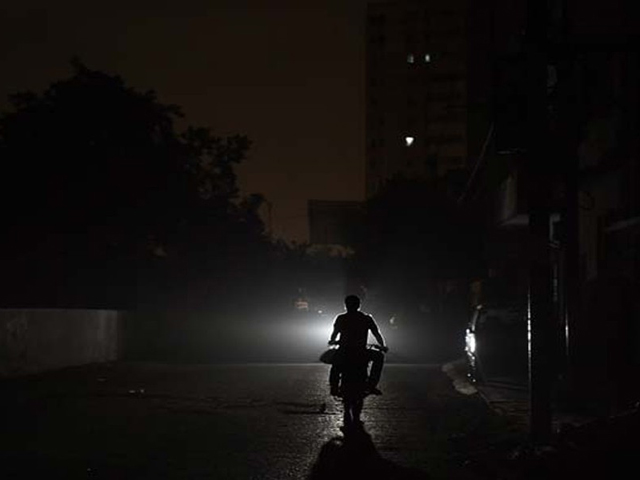
All of Sindh was plunged into darkness on Saturday night, along with the rest of the country, when the national grid hit a major snag, reportedly due a breakdown at the Guddu power plant, causing power stations across the country to trip. By Sunday evening, the power supply to most towns and cities was reportedly restored.
Restoration process
Karachiites are often left in the dark given frequent power outages and load management by the K-Electric. This time, however, the fault arose at the national grid, causing a nation-wide blackout.
According to a statement issued by KE on Sunday evening, the power utility’s teams had been working to restore power since midnight - it was around 11.45pm that the entire city was left without power - and electricity supply was restored in an incremental manner through the KE’s transmission and distribution networks. By late evening, supply from the national grid was resumed through existing interconnection points with the KE, read the statement. “Most parts of Karachi have been energised already, while teams are available to address individual customer complaints received at its 118 call centre,” stated the power utility.
On a regular day, the KE avails around 650 megawatts of electricity from the national grid while its own capacity from power plants in Bin Qasim and Korangi have a capacity of generating around 1,500MW of electricity. Besides, the KE draws around 300MW of electric supply from other private power plants. During the winter season, electricity demand in the metropolis is between 2,200 to 2,400 megawatts (MW) and on Saturday evening, the KE was utilising some 400MW of electricity from the national grid. When the fault hit, KE’s system was also affected.
After the nation-wide breakdown occurred, the KE began its restoration efforts by first isolating itself from the national grid and relied on power generation from its Bin Qasim power plant and the independent power plants (IPPs). In this manner, it was able to ensure restoration of power to various districts in phases, and by 10am power was restored to several areas of the city, and to most by 1pm on Sunday. However, some 200 to 300 feeders were still affected till later on in the day.
Meanwhile, restoration began nearly 14 hours after the breakdown on Sunday afternoon by the Hyderabad Electric Supply Company (HESCO), which powers 13 districts of Hyderabad, Nawabshah and Mirpurkhas divisions.
“We started getting electric supply at 132kv Nawabshah grid station from the 500kv line from Dadu district at 1.30pm on Sunday,” a senior official of the HESCO told The Express Tribune. And, the restoration continued in an incremental way till the evening.
A similar situation existed in the districts of Sukkur and Larkana divisions, which are powered by the Sukkur Electric Power Company.
The breakdown also left industrial zones without electricity for almost 17 hours. An official of HESCO told that when the restoration began, the domestic consumers remained the company’s priority. By around 3.30 pm, 225 out of 550 electricity feeders of HESCO and 50 out of 79 grid stations were restored. However, the power supply to only one of the three SITE areas in Nooriabad was revived.
By 5.15pm the HESCO was able to electrify all of its 79 grid stations and 400 of its feeders while 150 feeders were kept on rotation. It was by that time that Hyderabad and Kotri SITE areas began to get the power supply.
Rendered powerless
Prior to the incremental restoration process, however, people were forced to spend a chilly winter night without heating facilities from electricity and/or gas powered appliances. Due to gas load shedding in several districts, scores of citizens were also deprived of the use of generators.
Water shortage, which already prevails in several districts during the annual closures of water canals for repair and maintenance works, was aggravated in many districts.
During the power outage, major pumping stations of the Karachi Water and Sewerage Board were affected. Consequently, 357 million gallons of water could not be supplied to areas in the metropolis. Water supply was restored from Gharo, Dhabeji, NEK, Hub and other pumping stations after their electricity supply was restored between 11am and 12pm on Sunday.
However, the KWSB warned that the effects of low water supply may be felt in some areas of the city. Equal distribution of water is being prioritised but citizens are urged to use water mindfully, said KWSB Chairperson Syed Nasir Hussain Shah, speaking to The Express Tribune.
Meanwhile, the blackout also affected hospital services in both the public and the private sectors. Hospitals in the metropolis relied on back-up generators and no untoward incident was reported.
“Secretary health was on board with all heads of hospitals all night...All was managed nicely and all was well,” said Dr Seemin Jamali of the Jinnah Postgraduate Medical Centre. “Our electricity was restored by 10am,” she confirmed.
Moreover, people from several districts and cities reportedly experienced a drop in mobile phone signals and disturbed internet connectivity. The problem persisted in some areas till the filing of this report.
Published in The Express Tribune, January 11th, 2021.


















COMMENTS
Comments are moderated and generally will be posted if they are on-topic and not abusive.
For more information, please see our Comments FAQ